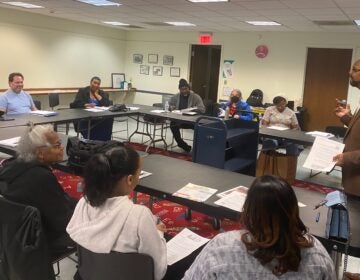Roxborough’s Statue of Liberty ‘waver’ views tax season as a chance to meet the neighbors
If you live in the Roxborough area, chances are you’re familiar with Tom Humphrey, the friendly Liberty Tax mascot decked out in a green, velvet-like Statue of Liberty costume on Ridge Avenue.
For four hours at a time, three-and-a-half months of the year, Humphrey greets pedestrians and drivers with a simple smile, and a wave.
Humphrey is one of four costumed personnel employed by Liberty Tax in Roxborough to attract customers and the curious. Known as “wavers,” Humphrey was the employee working the street yesterday afternoon, plying procrastinators and bringing in other last-minute clientele hoping to meet the IRS’s April 17 filing deadline.
Wearing a verdigris-colored robe and matching seven-point crown, his seasonal duties consist of waving, smiling, and enduring whatever ambient climactic conditions are present.
But when the clock struck midnight – and tax season officially ended – Humphrey was on to his next gig.
He’s also an employee of the Board of Elections, and will begin preparations today for the upcoming primary in his Roxborough ward.
With tax time ticking away yesterday, Humphrey was making the most of his final hours of Liberty.
“It’s fun,” said Humphrey of his job, while extending a hand to greet passing motorists. “You get to meet a lot of neighbors you don’t talk to every day.”
‘He’s the go-to-guy’
Describing Humphrey, Liberty Tax’s Charlie Miller said, “He’s the go-to guy.”
Miller is co-owner of the Ridge Ave. office, and has witnessed Humphrey’s loyalty and hard work for four years. In fact, Miller pointed out that even though Humphrey is still recovering from an accident suffered last October, he couldn’t be held back.
Miller is no stranger to hard work himself – during tax season, Liberty Tax is open seven days a week, and often experiences a surge of customers at the end of the season.
He noted that while electronic tax preparation has made a dent in his business, the intricacies of e-filing result in quite a few customers resorting to brick-and-mortar sites.
“We fix Turbo Tax,” Miller said. “We step in and do repairs.”
In other cases, he observed, there are many customers who attempted online filing in previous years and, scarred by the ordeal, vowed never to repeat the process.
Whatever their reasons, Miller related that a majority of his customers are drawn in by the Liberty wavers – he estimates as many as 80-percent.
The appeal
While the figure offered by Miller may seem overstated, research conducted by Liberty Tax confirms the appeal of the wavers.
“Our wavers are the number one way we get business,” said Martha O’ Gorman, chief marketing officer for Liberty Tax. “When polled,” she continued, “our customers overwhelmingly say that is the reason they found us and why they came into the store.”
According to O’Gorman, the origins of the Liberty Tax wavers began in 1999 while filming a TV spot in Washington, DC.
“We had someone dressed in the costume … and he attracted so much attention we thought, ‘Hey why not do this at every store during tax season?'”
At present, Liberty Tax employs approximately 10,000 people to wave at its 4,000 offices – most have 2 to 4 wavers. According to O’Gorman, most usually work about a month during the beginning of the season. The very best ones – like Humphrey – work for the full 15 weeks of tax season.
Asked to characterize response to wavers from both franchise operators and the public, O’Gorman said, “They love it.”
From the business perspective, she said it is inexpensive and effective marketing strategy that results in instantaneous generation of clients.
O’Gorman related that she too has donned the outfit for franchisee training.
“You would be amazed how it transforms your personality,” she said. “People can’t say no to the Statue of Liberty.”
The seasonal switch
Kathleen Barker, professor of Psychology at CUNY and co-editor of a book entitled “Contingent Work: American Employment Relations in Transition,” spoke to the psychological reasons for this transformation.
In the case of Liberty’s wavers – or any other costumed workers – there is freedom to accept such employment because they are “personally invisible.”
“There is no fear of evaluation from passing neighbors,” Barker said of such employees, “because they cannot be identified.”
This anonymity results in “deindividuation” – the loss of self-awareness.
“When we are not disguised,” she observed, “we interact with others on the job, and some amount of evaluation apprehension in group situations is normal.” She noted that these fears can be lifted under certain circumstances – like the physical anonymity afforded by a costume.
In addition, Barker suggested that the challenge of finding work in a struggling economy alters the perception of what constitutes normative attitudes and behavior toward occupations, possibly leading one to the conclusion that “being dressed in a green outfit is not all that bad.”
What’s next for Humphrey?
Eschewing meaning and implication, for Humphrey, the job is about duty. He’s always ready to work – whether it’s yesterday’s heat or previous year’s blizzards.
While it’s not always easy – close encounters with both traffic and meddling teenagers keep Humphrey on his toes – when he hangs up his Liberty Tax-supplied costume, he’s already looking ahead to upcoming tax seasons.
“Next year is already planned,” he said. “January 7, 2013, I’ll come out here and do this all over again.”
WHYY is your source for fact-based, in-depth journalism and information. As a nonprofit organization, we rely on financial support from readers like you. Please give today.




